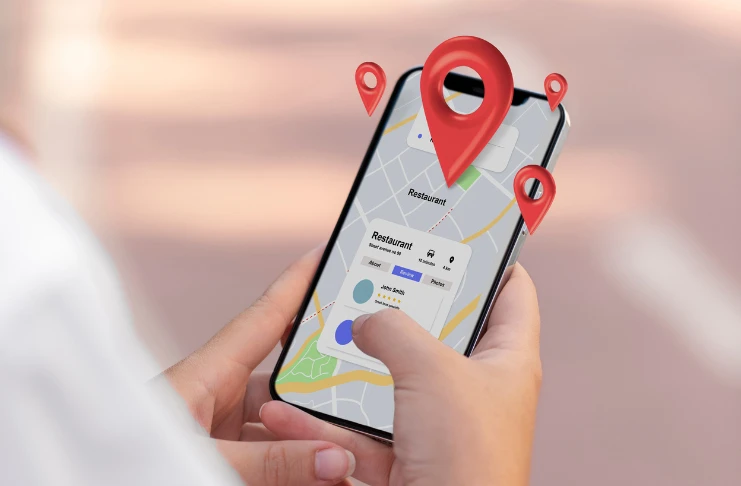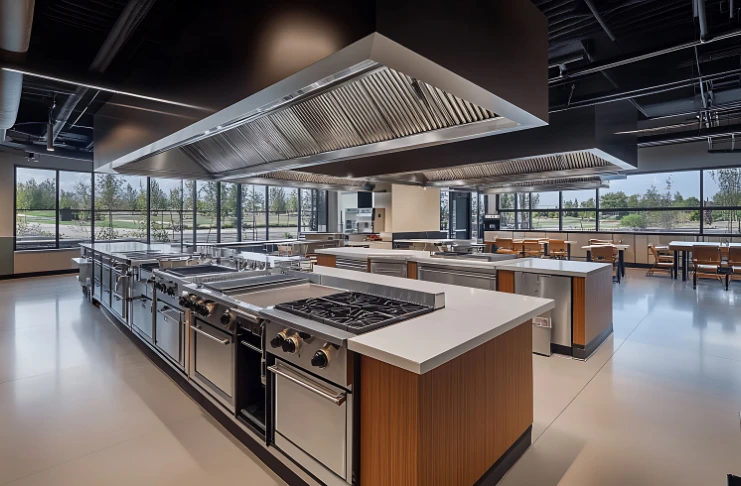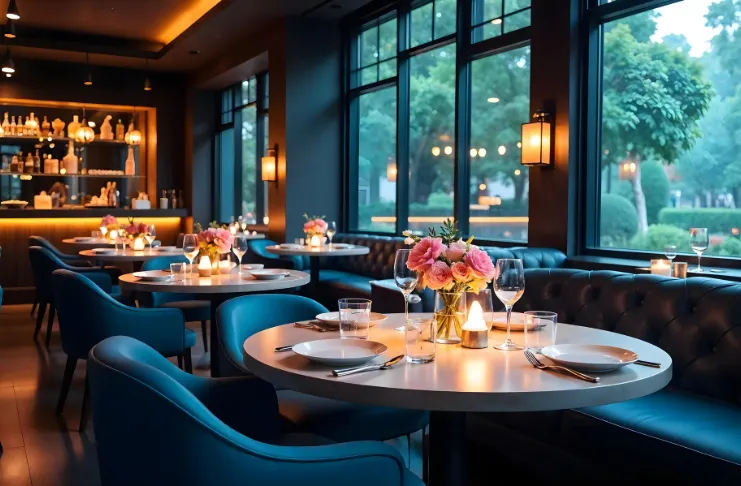Opening a restaurant is one of the most rewarding yet challenging entrepreneurial ventures you can pursue. As this restaurant startup guide will show, the food service industry offers immense opportunities for creative expression, community impact, and long-term financial success. However, learning how to open a restaurant the right way requires much more than just a passion for food.
The steps to start a restaurant business involve careful planning, in-depth market research, financial discipline, operational strategy, and a laser focus on customer experience. Many first-time restaurant owners underestimate the complexities of launching a restaurant—from concept development to licensing, staffing, menu design, and marketing.
This complete restaurant startup guide will walk you through every critical phase of opening a restaurant from scratch. Whether you’re dreaming of a cozy café, a fast-casual eatery, or a high-end fine dining destination, you’ll learn what it really takes to succeed in today’s competitive food service business.
With new technologies, changing consumer preferences, and evolving dining trends, understanding the different types of restaurants to open and how to position your business accordingly is more important than ever. This guide will help you avoid costly mistakes and build a restaurant that stands the test of time.
Understanding Different Types of Restaurants to Open
Choosing the right restaurant concept is key to success, influencing your target market, operations, and brand identity. Whether you prefer the convenience of fast-casual, the elegance of fine dining, the flexibility of a food truck, or the innovation of pop-up restaurants, understanding each model’s strengths and challenges helps you make the best choice for your vision and resources.
Fast-Casual Dining Concepts
Fast-casual restaurants are among the most promising opportunities for modern restaurateurs, blending convenience with quality to meet evolving consumer expectations.
- Appeals to health-conscious diners with fresh, made-to-order meals
- Offers quick service with higher-quality ingredients and customizable menus
- Popular formats include build-your-own bowls, gourmet burgers, and artisanal sandwiches
- Moderate to high startup costs, with emphasis on tech integration and streamlined operations
Their versatility, customer appeal, and operational efficiency make fast-casual restaurants a compelling choice for first-time and seasoned restaurant owners alike.
Fine Dining Establishments
Fine dining restaurants offer a premium culinary experience, combining gourmet cuisine, refined service, and an upscale atmosphere tailored to sophisticated diners.
- Caters to affluent guests seeking special occasions, business dining, or high-end culinary experiences
- Demands significant investment, expert chefs, and advanced hospitality management
- Relies on top-tier service, complex dishes, and a curated wine or beverage program
- Requires a prime location with access to a high-income customer base
For those with the passion, resources, and expertise, fine dining can deliver prestige, high margins, and long-term brand equity in the competitive restaurant landscape.
Food Truck and Mobile Concepts
Food trucks offer an affordable and flexible entry point into the competitive restaurant industry. They provide culinary entrepreneurs with mobility, lower startup costs, and the freedom to experiment with unique and trendy menu concepts, making them a popular choice for launching a food business.
- Requires significantly lower startup and operating costs compared to traditional restaurants.
- Provide mobility to reach diverse customer bases by serving at multiple locations, festivals, and special events.
- Ideal for showcasing ethnic cuisines, creative fusion street foods, and popular dessert trends.
- Necessitate obtaining permits, adhering to strict food safety regulations, and mastering efficient operations in a compact space.
With a well-defined strategy, strong branding, and quality offerings, food trucks can cultivate loyal local followings and often serve as effective stepping stones toward establishing successful brick-and-mortar restaurants.
Steps to Start a Restaurant Business

Thorough market research and a well-defined restaurant concept are vital to building a successful dining business. Understanding your local market, customer preferences, and financial feasibility guides smart decisions for a new restaurant, while a clear, unique concept helps you stand out and connect with your target audience for lasting success.
INDUSTRY INSIGHT
| In the U.S., 38% of Millennials and 24% of Gen Z dine out over five times a month, underscoring a strong, consistent demand for restaurant experiences. This makes the food service industry a highly profitable venture for those who enter it with the right concept and strategy. Opening a restaurant today isn’t just about great food—it’s about smart planning, branding, and execution to capture this eager market. |
Market Research and Feasibility Analysis
Conducting thorough market research is a crucial first step in launching a successful restaurant. Understanding your local dining landscape and customer preferences allows you, as a business owner, to tailor your concept to meet real demand and stand out in a competitive market.
- Analyze menus, pricing, service quality, and customer demographics of nearby restaurants.
- Observe foot traffic and peak dining hours to optimize your operational planning.
- Study your target audience’s income levels, tastes, and lifestyle habits for better menu and marketing alignment.
- Perform detailed financial feasibility assessments, including realistic revenue forecasts and cost estimates.
Comprehensive market research empowers you to develop a restaurant concept that resonates with your community, minimizes risks, and maximizes the potential for long-term success.
Developing Your Restaurant Concept
A strong restaurant concept shapes your entire business and helps you stand out in a crowded market. Defining what makes your restaurant unique is crucial for attracting and retaining customers. A successful restaurant concept:
- Addresses unmet customer needs or niches that competitors overlook
- Clearly outlines target customers, menu style, service approach, and pricing
- Balances clarity with flexibility to evolve based on market feedback
- Is tested through focus groups, pop-ups, or catering to refine before launch
Developing and validating your concept early ensures a focused, adaptable foundation that increases your chances of long-term success.
Legal Requirements and Business Structure

Choosing the appropriate business structure and obtaining all required licenses and permits are critical early steps in establishing your restaurant. These decisions influence your legal liability, tax obligations, funding options, and overall business flexibility. Additionally, navigating the often complex licensing process ensures your restaurant complies with health, safety, and local regulations. Careful planning and expert guidance in these areas help build a solid foundation for your restaurant’s successful launch and ongoing operations.
Choosing the Right Business Structure
Choosing the right business structure is a vital step that influences your restaurant’s legal liability, tax obligations, and future growth opportunities. Selecting the appropriate entity ensures you protect your personal assets while optimizing financial and operational flexibility.
- Sole proprietorships and partnerships offer easy setup but provide limited liability protection.
- Limited Liability Companies (LLCs) combine personal asset protection with flexible tax options.
- Corporations deliver strong liability protection and facilitate capital raising, but involve more complex regulations.
- S-corporations help avoid double taxation, offering tax advantages on distributed profits.
Consulting with legal and financial professionals is essential to choosing the business structure that best aligns with your restaurant’s ownership, objectives, and risk tolerance.
Obtaining Necessary Licenses and Permits
Navigating restaurant licensing is a critical process that ensures your business complies with legal requirements and maintains health and safety standards. Securing the right permits is essential for a smooth launch and ongoing operations.
- Food service licenses require thorough health inspections of kitchens and sanitation practices.
- Liquor licenses often involve detailed applications, fees, and sometimes public hearings.
- Business licenses, building permits, signage approvals, and fire safety clearances are also necessary.
- Starting the licensing process early helps avoid delays and ensures compliance with local regulations.
Careful planning and proactive management of licenses prevent costly setbacks and keep your restaurant on track for a successful opening.
Location Selection and Lease Negotiation

Selecting the ideal location and securing favorable lease terms are critical steps in setting your restaurant up for long-term success. The right site attracts your target customers and supports strong sales, while well-negotiated lease agreements protect your financial health and provide operational flexibility. Careful evaluation and negotiation ensure a solid foundation for your restaurant’s growth.
Evaluating Potential Locations
Choosing the right location is one of the most important factors that can make or break your restaurant’s success. A good restaurant location:
- Offers strong foot traffic, visibility, and convenient parking for your target customers
- Aligns local demographics with your restaurant’s concept and price points
- Reflects traffic patterns that match your operating hours and customer habits
- Considers competition to find opportunities for differentiation and market gaps
Careful location analysis helps ensure your restaurant attracts the right audience and maximizes its revenue potential from day one.
Lease Terms and Negotiation Strategies
Negotiating your commercial lease wisely is essential to protect your restaurant’s finances and operational flexibility. Key points in restaurant lease negotiations include:
- Ensuring base rent aligns with industry standards, typically 6% to 10% of gross sales
- Carefully handling percentage rent clauses with realistic sales breakpoints
- Securing tenant improvement allowances to offset build-out costs
- Negotiating assignment and subletting rights for future business flexibility
Effective lease negotiations can save money upfront and prevent costly restrictions that hinder your restaurant’s growth.
Financial Planning and Funding

Developing comprehensive financial projections and identifying suitable funding sources are essential steps for launching a successful restaurant. Detailed forecasts guide your planning and help attract investors, while understanding various financing options ensures you secure the capital needed to support your vision and sustain operations through growth and challenges.
Creating Detailed Financial Projections
Accurate financial projections are vital for planning, securing funding, and tracking your restaurant’s performance against goals. Effective restaurant financial projections should include:
- Realistic revenue forecasts based on customer traffic, average check size, and seasonality
- Detailed operating expense budgets covering food, labor, occupancy, marketing, and more
- Cash flow analyses to identify funding needs and manage seasonal fluctuations
- Use of industry benchmarks tailored to your concept and location for precise estimates
Well-prepared financial projections increase your chances of securing investment and keeping your restaurant financially healthy through growth phases.
Funding Sources and Investment Options
Securing the right funding mix is crucial to successfully launching and sustaining your restaurant. Restaurant funding options typically include:
- Personal investment to demonstrate commitment and lower lender risk
- Traditional bank loans and SBA loans with favorable terms but detailed requirements
- Equipment financing tailored for kitchen and technology purchases using collateral
- Equity investments from angel investors or restaurant-focused groups for growth capital
Choosing the right combination of funding sources helps balance financial risk and operational control as you build your restaurant business.
Menu Development and Pricing Strategy

Crafting a well-designed menu and pricing strategy is essential to both delight your customers and maintain healthy profit margins. Your menu should reflect your concept while ensuring operational efficiency, and pricing must balance costs, customer perceptions, and competitive positioning to drive sustainable restaurant success.
Creating Your Core Menu
Developing a well-crafted menu is key to delivering a memorable dining experience while maintaining profitability and operational efficiency. Effective restaurant menu development involves:
- Aligning menu items with your restaurant concept and kitchen capabilities
- Keeping the menu focused to highlight your unique offerings and simplify operations
- Planning ingredient overlap to reduce costs, waste, and streamline inventory
- Incorporating seasonal dishes to keep the menu fresh and leverage ingredient availability
A thoughtfully designed menu balances creativity with practicality, helping attract customers and boost your restaurant’s success.
Pricing for Profitability
Setting the right menu prices is crucial for attracting customers and ensuring your restaurant remains profitable. Key factors in effective menu pricing include:
- Calculating food costs accurately, typically aiming for 25% to 35% of the menu price
- Accounting for labor costs, especially for dishes with complex preparation or longer cook times
- Using psychological pricing strategies to influence customer choices and enhance perceived value
- Designing the menu layout to optimize price anchoring and portion sizes for maximum revenue
Smart menu pricing balances customer appeal with business sustainability, helping your restaurant thrive in a competitive market.
Kitchen Design and Equipment Selection

Efficient kitchen design and the right equipment are critical foundations for any successful restaurant. A thoughtfully planned back of house layout enhances workflow, safety, and food quality, while carefully selected tools and technology ensure smooth operations, cost management, and the ability to deliver your menu consistently.
Planning Your Kitchen Layout
A well-designed kitchen is essential for smooth restaurant operations, consistent food quality, and staff productivity. Key elements of effective restaurant kitchen design include:
- Creating a workflow that follows logical food preparation steps from storage to service
- Designing traffic patterns to minimize cross-contamination and prevent bottlenecks
- Strategically placing equipment to meet utility needs and allow safe, efficient use
- Incorporating ample storage for refrigeration, dry goods, and cleaning supplies
Thoughtful kitchen design supports your team’s efficiency and helps maintain high standards in food preparation and safety.
Essential Equipment and Technology
Choosing the right kitchen equipment is vital for efficient operations, cost control, and menu execution. Important considerations for restaurant kitchen equipment selection include:
- Matching cooking equipment to your menu’s preparation methods and volume needs
- Prioritizing durability, ease of maintenance, and reliable vendor support
- Selecting energy-efficient refrigeration to ensure food safety and reduce costs
- Implementing scalable point-of-sale systems for seamless ordering, payments, and inventory tracking
Smart equipment choices enhance operational reliability and support long-term restaurant success.
Staffing and Human Resources

Hiring and developing the right team is fundamental to running a successful restaurant. Attracting skilled staff, providing clear role expectations, and investing in comprehensive training programs create a strong foundation for consistent quality, excellent service, and a positive workplace culture that drives long-term success.
Hiring the Right Team
Building a skilled and motivated team is essential for your restaurant’s success and smooth daily operations. Key points in recruiting and managing restaurant staff include:
- Creating clear job descriptions and offering competitive compensation to attract top talent
- Hiring experienced kitchen staff, especially a head chef who ensures food quality and efficient kitchen management
- Selecting front-of-house employees with strong hospitality skills and customer-focused attitudes
- Employing managers with industry experience and leadership abilities to oversee operations and maintain standards
Investing in the right team fosters excellent service, consistent quality, and a positive work environment that supports growth.
Training and Development Programs
78% of customers have backed out of a purchase due to a poor customer experience. Effective training programs are the backbone of consistent restaurant operations and exceptional customer experiences. Key aspects of restaurant staff training include:
- Developing detailed training materials covering all roles and responsibilities
- Providing mandatory food safety education on handling, sanitation, and emergency procedures
- Teaching service standards, menu details, and customer engagement skills through interactive methods
- Cross-training employees to increase flexibility and create opportunities for career growth
Comprehensive training not only ensures quality and compliance but also boosts employee satisfaction and retention.
Marketing and Customer Acquisition

A well-planned marketing strategy before and during your restaurant’s opening is key to generating excitement and attracting a steady flow of customers. By engaging your community, leveraging media, and creating memorable launch events, you set the stage for lasting success and build a loyal customer base from day one.
Pre-Opening Marketing Strategy
Creating buzz before your grand opening lays the groundwork for long-term success by attracting early customers and establishing your brand identity. Smart pre-opening marketing includes:
- Launching engaging social media campaigns that document your restaurant’s journey and tease menu highlights
- Reaching out to local media outlets for press coverage, chef interviews, and feature stories
- Partnering with community organizations and participating in events to build goodwill and recognition
- Hosting soft openings or preview nights to generate word-of-mouth buzz and collect early feedback
Strategic pre-launch marketing helps you open with momentum and a loyal base of curious, eager diners.
Grand Opening and Launch Events
A successful grand opening sets the tone for your restaurant’s brand, draws attention from local communities, and kickstarts strong word-of-mouth marketing.
- Begin with a soft launch to fine-tune operations and gather real-time feedback.
- Host media nights and influencer tastings to amplify reach and generate online buzz
- Offer compelling launch-day promotions to encourage trial and repeat visits.
- Create memorable guest experiences that reflect your brand’s personality and concept.t
Launching with intention builds early momentum, helping convert curious first-timers into loyal returning guests.
Operations Management and Quality Control

Effective daily operations and exceptional customer service are fundamental to a restaurant’s lasting success. By implementing standardized systems and fostering a strong service culture, you ensure consistent quality, operational efficiency, and memorable guest experiences that drive repeat business and build a loyal customer base.
Daily Operations Systems
Standardized systems form the backbone of smooth restaurant operations, ensuring consistency, efficiency, and accountability across every department.
- Use detailed opening and closing checklists to maintain cleanliness, safety, and readiness standards.
- Implement robust inventory systems to track stock levels, minimize waste, and optimize purchasing.
- Maintain quality control through documented procedures, regular audits, and real-time feedback loops.
- Clearly define roles and responsibilities so that staff know what’s expected and processes remain streamlined.
When systems run smoothly behind the scenes, it creates a reliable, high-quality experience that keeps customers coming back.
Customer Service Excellence
Exceptional customer service sets your restaurant apart in a crowded market and turns one-time visitors into loyal patrons.
- Train staff to consistently deliver service aligned with your brand’s values and exceed guest expectations
- Empower employees with protocols to handle complaints and special requests with empathy and efficiency.
- Collect and monitor customer feedback from reviews, surveys, and in-person conversations to drive improvements.
- Recognize and reward staff members who go above and beyond, reinforcing a strong culture of hospitality.
Outstanding service isn’t just a nice touch—it’s a strategic advantage that cultivates loyalty and fuels long-term growth.
Financial Management and Growth Planning

Monitoring key performance indicators (KPIs) is essential for understanding your restaurant’s operational health and financial success. Regularly tracking these metrics enables informed decisions to improve efficiency and profitability. As your restaurant grows, thoughtful planning for expansion ensures you scale sustainably while maintaining quality and brand consistency across new opportunities.
Monitoring Key Performance Indicators
Metrics help identify operational strengths, profitability trends, and areas needing improvement, enabling smarter, data-driven decisions.
- Track food cost percentages, labor cost ratios, and average check sizes to measure operational efficiency.
- Compare actual performance with budgets and industry benchmarks for improvement insights.
- Analyze customer traffic, table turnover, and peak hours to optimize staffing and hours.
- Monitor cash flow to avoid liquidity issues and plan for seasonal changes and growth.
Regularly reviewing these KPIs ensures your restaurant stays financially healthy and ready to scale efficiently.
Planning for Growth and Expansion
Successful restaurants often face the opportunity to grow by opening additional locations, expanding catering services, or adapting their concepts. Careful growth planning is essential to capitalize on market potential while managing operational and financial challenges.
- Analyze target markets for demographics, competition, and location availability.
- Assess if your concept fits new markets and customer preferences.
- Ensure systems and management can scale without sacrificing quality.
- Plan finances carefully, securing capital and projecting realistic returns.
Thoughtful expansion strategies help restaurants grow sustainably while preserving brand integrity and profitability.
Common Challenges and Solutions

Starting a restaurant is an exciting but challenging endeavor, with many potential obstacles along the way. By anticipating common startup challenges—such as cash flow issues, staffing, permits, and market shifts—you can prepare effective strategies to overcome them. Success demands adaptability, thorough planning, and a commitment to continuous learning as you build a thriving, resilient restaurant business.
Overcoming Startup Obstacles
Starting a restaurant is an exciting venture, but it comes with common challenges that can impact your success if not addressed early. Preparing for these obstacles ahead of time helps ensure a smoother launch and stronger foundation.
- Cash flow shortages often happen before and just after opening; keep larger reserves and backup funding.
- Staffing issues like hiring, training costs, and turnover affect service and consistency.
- Permit delays, construction setbacks, and equipment problems can delay your launch and raise costs.
- Build in time buffers and flexible budgets to handle unexpected problems smoothly.
By anticipating these challenges and planning solutions early, you increase your chances of a successful, timely, and smooth restaurant opening.
Adapting to Market Changes
The restaurant industry is rapidly evolving due to shifting consumer preferences, technological advances, economic changes, and increasing competition. Staying adaptable and innovative is essential for restaurant owners who want to thrive in this fast-changing environment.
- Technology integration, such as online ordering, delivery platforms, and modern payment systems, is now crucial for reaching customers and staying competitive. Restaurants offering digital payment options like apps or kiosks see 14% higher ticket sizes and 30% more in tips.
- Health and safety standards have tightened, requiring enhanced sanitation procedures, contactless services, and operational changes that prioritize well-being.
- Economic fluctuations influence customer spending and operating costs, making flexible business models and scenario planning necessary to maintain profitability.
- Ongoing adaptation involves combining creativity with strong business planning and responsiveness to market feedback.
Success in the restaurant industry depends on thorough preparation, smart execution, and continuous improvement. By remaining flexible and proactive, your restaurant can grow into a thriving business and a beloved community destination.
Conclusion
Opening a restaurant is a journey that blends passion, creativity, and entrepreneurial grit. While the process can be demanding, following a clear roadmap significantly improves your chances of success. This restaurant startup guide has walked you through the critical steps to start a restaurant business—from crafting your concept and securing funding to designing your space, hiring the right team, and executing a flawless launch.
Remember, successful restaurants don’t happen by chance. They are built through informed decisions, consistent effort, and a deep understanding of your market and customers. By being strategic, detail-oriented, and responsive to trends and feedback, you position yourself not just to survive, but to thrive.
As you move forward, keep revisiting your goals and refining your operations. The restaurant industry is dynamic, and staying agile is key. Whether you’re exploring different types of restaurants to open or aiming to grow your current concept, knowledge and adaptability are your greatest assets.
Launching your own dining establishment is no small feat, but with the right foundation, your restaurant can become a beloved fixture in your community. Use this guide as your go-to resource as you turn your vision into a vibrant, successful business. You now have a clear understanding of how to open a restaurant—the rest is execution.
Frequently Asked Questions
1. How much does it cost to open a restaurant?
Opening a restaurant typically costs between $100,000 and $500,000, depending on location, size, and concept.
2. Is $10,000 enough to open a restaurant?
$10,000 may be enough to start a small food cart, pop-up, or cloud kitchen, but not a full-scale restaurant.
3. How profitable is owning a restaurant?
Restaurant profit margins average 3%–10%, with success depending on concept, management, and location.
4. What is the 30/30/30/10 rule for restaurants?
The 30/30/30/10 rule is a budgeting guideline: 30% food costs, 30% labor, 30% overhead, and 10% profit.
5. How to start a restaurant step by step?
Starting a restaurant involves market research, business planning, licensing, location selection, hiring, and marketing.
6. How much money do you need to start a restaurant business?
You typically need $100,000–$500,000 or more to start a restaurant, depending on the model and location.
7. Is $10,000 enough to open a restaurant?
$10,000 can work for a low-cost model like a food truck or home kitchen, not a full-service restaurant.
8. What is the best type of restaurant to open?
The best type of restaurant to open depends on your budget, target market, and local demand—fast-casual and niche concepts are popular.
9. What is the most profitable restaurant food?
High-margin foods like pizza, pasta, and beverages are often the most profitable due to low ingredient costs.
10. How much money do you need to start a restaurant?
Startup costs vary widely by city, but expect to invest at least $100,000 for a brick-and-mortar location.
11. Do you need an LLC for a restaurant?
Forming an LLC is recommended as it protects your personal assets and separates business liability.





